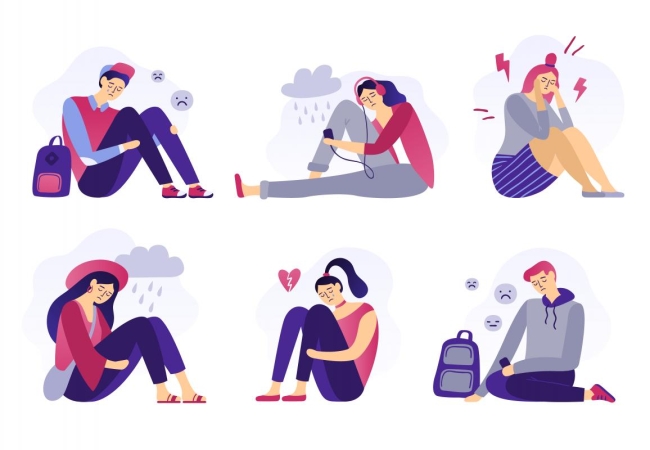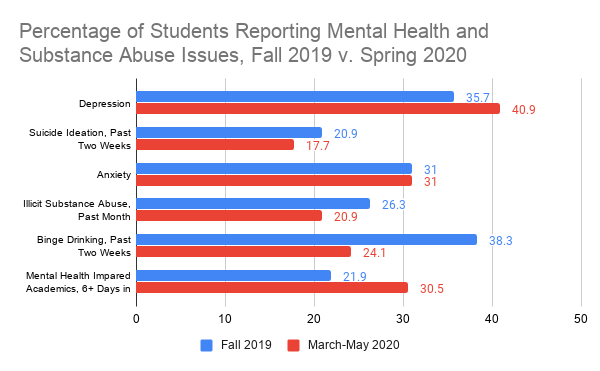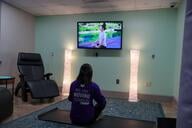You have /5 articles left.
Sign up for a free account or log in.

ISTOCK.COM/Tetiana Lazunova
Sixty percent of college students say the pandemic has made it harder to access mental health care, even as financial stresses and prevalence of depression increased among them, according to a new survey on the impact of COVID-19 on student well-being.
The survey by the Healthy Minds Network for Research on Adolescent and Young Adult Mental Health and the American College Health Association garnered results from 18,764 students on 14 campuses. Researchers say much of what they found is more confirmatory than surprising, but having the hard data will help colleges make decisions about providing mental health and well-being services to students.
Among the results:
- Sixty-six percent of students report the pandemic has caused them more financial stress -- “a known predictor of student mental health,” according to the report on the survey results -- and 35.7 percent say they’ve moved to a new living situation as a result of the pandemic.
- Prevalence of depression among college students increased since the pandemic caused the closure of campuses this spring compared to fall 2019, while prevalence of substance abuse decreased (see chart below). A higher proportion of students -- 30.5 percent compared to 21.9 percent the prior fall -- reported that their mental health negatively affected their academic performance on at least six days during the prior four weeks.
- About 15 percent of students report having a probable case of COVID-19, though less than 1 percent of students said the diagnosis was confirmed with a test. Among students who reported having confirmed or probable cases, 5.5 percent describe their symptoms as severe, 35.1 percent as moderate, 55.3 percent as mild and 4.1 percent said they were asymptomatic.
- Students express high levels of concerns about how long the pandemic will last. About a quarter of students -- 25.8 percent -- say they are “very” or “extremely” concerned about contracting the virus, while 64.4 percent say they are “very” or “extremely” concerned about a person they care about contracting COVID-19.
- Five and a half percent of students reported experiencing discriminatory or hostile behavior based on their race or ethnicity as a result of the pandemic, and 41 percent reported witnessing discriminatory behavior online or in person.
- The vast majority of students -- 84 percent -- say public health agencies are their most trusted source of information about the pandemic. About 60 percent say they have been “very closely” following recommendations for hygiene practices, and about 70 percent say they have been “very closely” following recommendations for physical and social distancing.
- Of the 41.8 percent of students who attempted to seek mental health care during the pandemic, 23.3 percent said it had been “much more difficult” to access care, and 36.8 percent said it was “somewhat more difficult.”
- About 69 percent of students said their campus administration has been supportive during the pandemic, and about 78 percent said their professors have been supportive.
 Mary Hoban, chief research officer for the American College Health Association, stressed that the data were collected during a fairly narrow window between March and May when colleges that hadn't used telehealth before the pandemic had to quickly put new telehealth systems in place. She said college counseling centers also struggled initially with state-level licensure regulations that prohibited providing mental health services across state lines; many of those regulations have been relaxed for the duration of the public health emergency.
Mary Hoban, chief research officer for the American College Health Association, stressed that the data were collected during a fairly narrow window between March and May when colleges that hadn't used telehealth before the pandemic had to quickly put new telehealth systems in place. She said college counseling centers also struggled initially with state-level licensure regulations that prohibited providing mental health services across state lines; many of those regulations have been relaxed for the duration of the public health emergency.
Hoban expects the picture for mental health access and college counseling center capacity will improve in the fall.
"Not to say that all the challenges will have been addressed, but we’ll have better systems in place for the cross-state licensure regulations and for establishing a new client, a new patient," she said. "Those were things that were bigger challenges in the beginning."
At the same time, Hoban expressed concern about the potential for colleges to cut spending on mental health services as they struggle with broader financial challenges. About 20 percent of institutions responding to a separate ACHA survey reported having unexpected staff reductions this summer.
Sarah Ketchen Lipson, co-principal investigator of the national Healthy Minds Study and assistant professor of health law, policy and management at Boston University, said the results highlight a need to protect budgets for mental health support and to make sure that students are aware of the resources available to them, including telehealth resources.
"The challenge before us is what can we do to increase access, increase students’ understanding of the mental health service landscape, which looks very different than how it looked before," she said.
Lipson said faculty have a heightened role to play in caring for students’ well-being and referring them to mental health services as needed. With students having fewer interactions with peers, athletic coaches and student life staff, she said that faculty have a heightened gatekeeping role. She suggested that faculty should put information about mental health and wellness resources in their syllabi and take time to mention those resources in their first class and at stressful points of the semester, such as during midterms and finals.
Lipson also highlighted a need for partnerships between on-campus counseling centers and financial aid offices in light of the financial stressors many students are facing.
David M. Arnold, the assistant vice president for health, safety and well-being initiatives for NASPA, an association of student affairs administrators, echoed the idea that responsibility for student mental health “is not the responsibility solely of the counseling center and clinical staff.”
“This survey’s data can help inform what questions campuses can be asking locally to craft both service delivery and design to better accommodate students,” Arnold said via email. “The data also helps to complete a picture of student needs beyond mental health. When basic needs (physiological, safety, security) are threatened, that threat carries into our mental health. Students’ feelings of economic uncertainty may be the larger threat campuses may try to adjust by ensuring continued student employment, internships, and other career services. The survey also does well to identify that the issues regarding COVID-19 do not exist in isolation to the exposure and public response to systemic racial oppression, which is directly material for mental health and social identity.”




